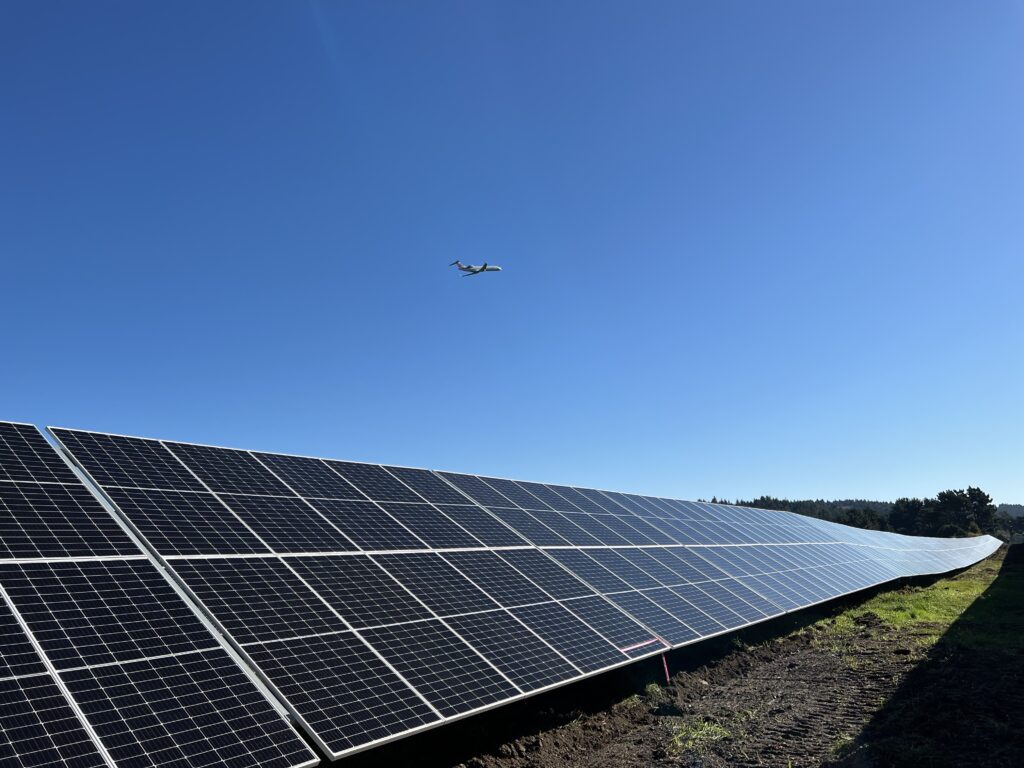A First for California
The Redwood Coast Airport Microgrid (RCAM) is a local energy project that has become a model for the rest of the nation. RCAM is the first 100% renewable, front-of-the-meter, multi-customer microgrid in California. It delivers clean, 100% dispatchable renewable power to Humboldt County utility customers and provides critical energy resilience for the California Redwood Coast-Humboldt County Airport and the U.S. Coast Guard Air Station.
RCAM is located at Humboldt County’s main commercial airport and was first brought online in late 2021. It consists of a 2.2 MW solar array DC-coupled with a 2.3 MW/8.9 MWh battery energy storage system, all operated by a microgrid control system, plus a 300 kW net metered solar system.

An Award-Winning Project
Impact Award in Reliability
The California Community Choice Association (CalCCA) recognized RCEA with a first place Impact Award in the Reliability category at their 2024 annual conference in San Diego.
California Microgrid Award
RCEA also won the California Microgrid award during Microgrid Knowledge’s 2023 Greater Good Award ceremony in Anaheim.
What is a Microgrid?
A microgrid is a small self-contained grid that is attached to the main electric grid. Being attached to the electric grid allows it to send and receive power from the main grid. During a power outage, however, the microgrid disconnects from the main grid, allowing it to run as its own energy island.
Microgrids can provide energy resilience for fire stations, hospitals, schools, grocery stores, and other critical infrastructures during power outages. In 2022-2024, RCAM was on stand-by or delivering resilient power through two major earthquakes (6.4 and 7.0), at least 14 atmospheric river events, and a bomb cyclone.
Solar Microgrids Explained
by Schatz Energy Research Center at Cal Poly Humboldt
About RCAM
The Team
RCAM was developed by a multi-talented team working together closely over 5 years to design, permit, construct, and commission the system. Team members included:
- California Energy Commission: project funder through a $5M EPIC grant
- Rural Utilities Service (RUS) of the USDA: project funder through a $6.5M low-interest loan
- Federal Aviation Administration (FAA): project permitting body
- County of Humboldt and its Aviation Division: owner of the airport
- Schatz Energy Research Center at Cal Poly Humboldt: prime contractor and technology integrator
- Redwood Coast Energy Authority (RCEA): local Community Choice Aggregator and owner of the RCAM generation system
- Pacific Gas and Electric Company (PG&E): local utility and owner of the RCAM distribution lines
- Schweitzer Engineering Labs: vendor for the control hardware and software
- Tesla, Inc.: vendor for the photovoltaic and battery system
- The Energy Authority: consultant and scheduling coordinator for market participation with the California Independent System Operator (CAISO)
- TRC: consultant for the business case and cybersecurity analyses
RCAM as a Role Model
As the first-of-its-kind project in California, RCAM serves as a role model for other communities across the state striving to green their energy supply and provide critical resilience in the face of climate change. Some of these “firsts” are detailed below.
Large Battery
RCAM’s large battery allows it to store solar energy during the day and release it onto the grid as needed in the evening and during peak demands. This enables greater utilization of solar, supports grid reliability, and creates an economic model for future microgrids. As the county’s Community Choice Aggregator, it is an important step toward RCEA’s goal to provide its customers with 100% renewable and carbon-free electricity by 2025 and 100% net-zero-carbon-emission renewable electricity by 2030.
Local Government Ownership
This project demonstrates local government ownership and operation of renewable energy generation resources with full interoperability and coordination with PG&E, the distribution system operator. During normal blue-sky operations, RCEA controls RCAM to generate clean energy for the North Coast and participates in the CAISO wholesale energy markets, including the day-ahead, real-time, and ancillary services. In parallel, PG&E owns, operates, and maintains a microgrid distribution circuit and controls the microgrid intertie during “islanded” operation.
Protection from Outages During Emergencies
Humboldt County is particularly prone to earthquakes, tsunamis, fires, and floods. When these natural disasters cause a broader grid outage, the clean-energy microgrid will provide indefinite renewable power for the 19 connected customers at the airport by disconnecting or “islanding” from the broader grid when needed and becoming an independent, PG&E-operated grid segment. This ensures that airport flight service and Coast Guard rescue operations—critical lifelines for the county—continue without interruption.
Microgrid Operating Agreement
To support the parallel business requirements of RCEA and PG&E, the team developed a microgrid operating agreement (MOA) to establish understanding on topics such as interconnection, facility requirements, safety, commissioning, cybersecurity, operating procedures and protocols, and so on. This work led to PG&E’s Community Microgrid Enablement Program (CMEP) and the associated Community Microgrid Enablement Tariff (CMET).
Land for Energy
To compensate the County of Humboldt for the use of land under fiscal oversight of the Federal Aviation Administration, a portion of the array is configured as an aggregate-net-energy-metered facility. This electricity offsets onsite airport loads, acts in lieu of a lease payment, and helps to achieve the County’s climate action plan targets.